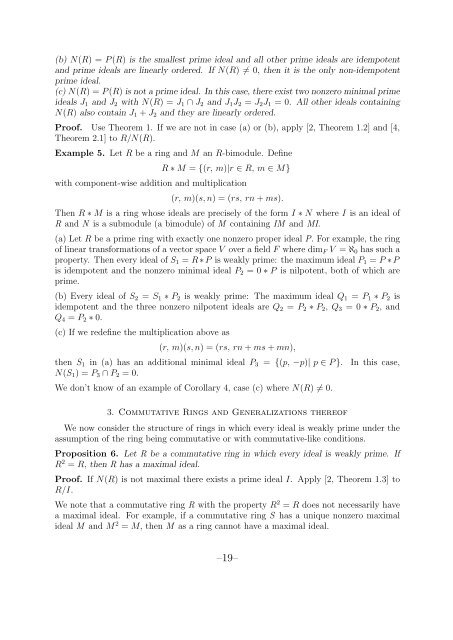Yasuyuki Hirano, Edward Poon and Hisaya Tsutsui
Yasuyuki Hirano, Edward Poon and Hisaya Tsutsui
Yasuyuki Hirano, Edward Poon and Hisaya Tsutsui
You also want an ePaper? Increase the reach of your titles
YUMPU automatically turns print PDFs into web optimized ePapers that Google loves.
(b) N(R) = P (R) is the smallest prime ideal <strong>and</strong> all other prime ideals are idempotent<br />
<strong>and</strong> prime ideals are linearly ordered. If N(R) ≠ 0, then it is the only non-idempotent<br />
prime ideal.<br />
(c) N(R) = P (R) is not a prime ideal. In this case, there exist two nonzero minimal prime<br />
ideals J 1 <strong>and</strong> J 2 with N(R) = J 1 ∩ J 2 <strong>and</strong> J 1 J 2 = J 2 J 1 = 0. All other ideals containing<br />
N(R) also contain J 1 + J 2 <strong>and</strong> they are linearly ordered.<br />
Proof. Use Theorem 1. If we are not in case (a) or (b), apply [2, Theorem 1.2] <strong>and</strong> [4,<br />
Theorem 2.1] to R/N(R).<br />
Example 5. Let R be a ring <strong>and</strong> M an R-bimodule. Define<br />
R ∗ M = {(r, m)|r ∈ R, m ∈ M}<br />
with component-wise addition <strong>and</strong> multiplication<br />
(r, m)(s, n) = (rs, rn + ms).<br />
Then R ∗ M is a ring whose ideals are precisely of the form I ∗ N where I is an ideal of<br />
R <strong>and</strong> N is a submodule (a bimodule) of M containing IM <strong>and</strong> MI.<br />
(a) Let R be a prime ring with exactly one nonzero proper ideal P. For example, the ring<br />
of linear transformations of a vector space V over a field F where dim F V = ℵ 0 has such a<br />
property. Then every ideal of S 1 = R ∗ P is weakly prime: the maximum ideal P 1 = P ∗ P<br />
is idempotent <strong>and</strong> the nonzero minimal ideal P 2 = 0 ∗ P is nilpotent, both of which are<br />
prime.<br />
(b) Every ideal of S 2 = S 1 ∗ P 2 is weakly prime: The maximum ideal Q 1 = P 1 ∗ P 2 is<br />
idempotent <strong>and</strong> the three nonzero nilpotent ideals are Q 2 = P 2 ∗ P 2 , Q 3 = 0 ∗ P 2 , <strong>and</strong><br />
Q 4 = P 2 ∗ 0.<br />
(c) If we redefine the multiplication above as<br />
(r, m)(s, n) = (rs, rn + ms + mn),<br />
then S 1 in (a) has an additional minimal ideal P 3 = {(p, −p)| p ∈ P }. In this case,<br />
N(S 1 ) = P 3 ∩ P 2 = 0.<br />
We don’t know of an example of Corollary 4, case (c) where N(R) ≠ 0.<br />
3. Commutative Rings <strong>and</strong> Generalizations thereof<br />
We now consider the structure of rings in which every ideal is weakly prime under the<br />
assumption of the ring being commutative or with commutative-like conditions.<br />
Proposition 6. Let R be a commutative ring in which every ideal is weakly prime. If<br />
R 2 = R, then R has a maximal ideal.<br />
Proof. If N(R) is not maximal there exists a prime ideal I. Apply [2, Theorem 1.3] to<br />
R/I.<br />
We note that a commutative ring R with the property R 2 = R does not necessarily have<br />
a maximal ideal. For example, if a commutative ring S has a unique nonzero maximal<br />
ideal M <strong>and</strong> M 2 = M, then M as a ring cannot have a maximal ideal.<br />
–19–















